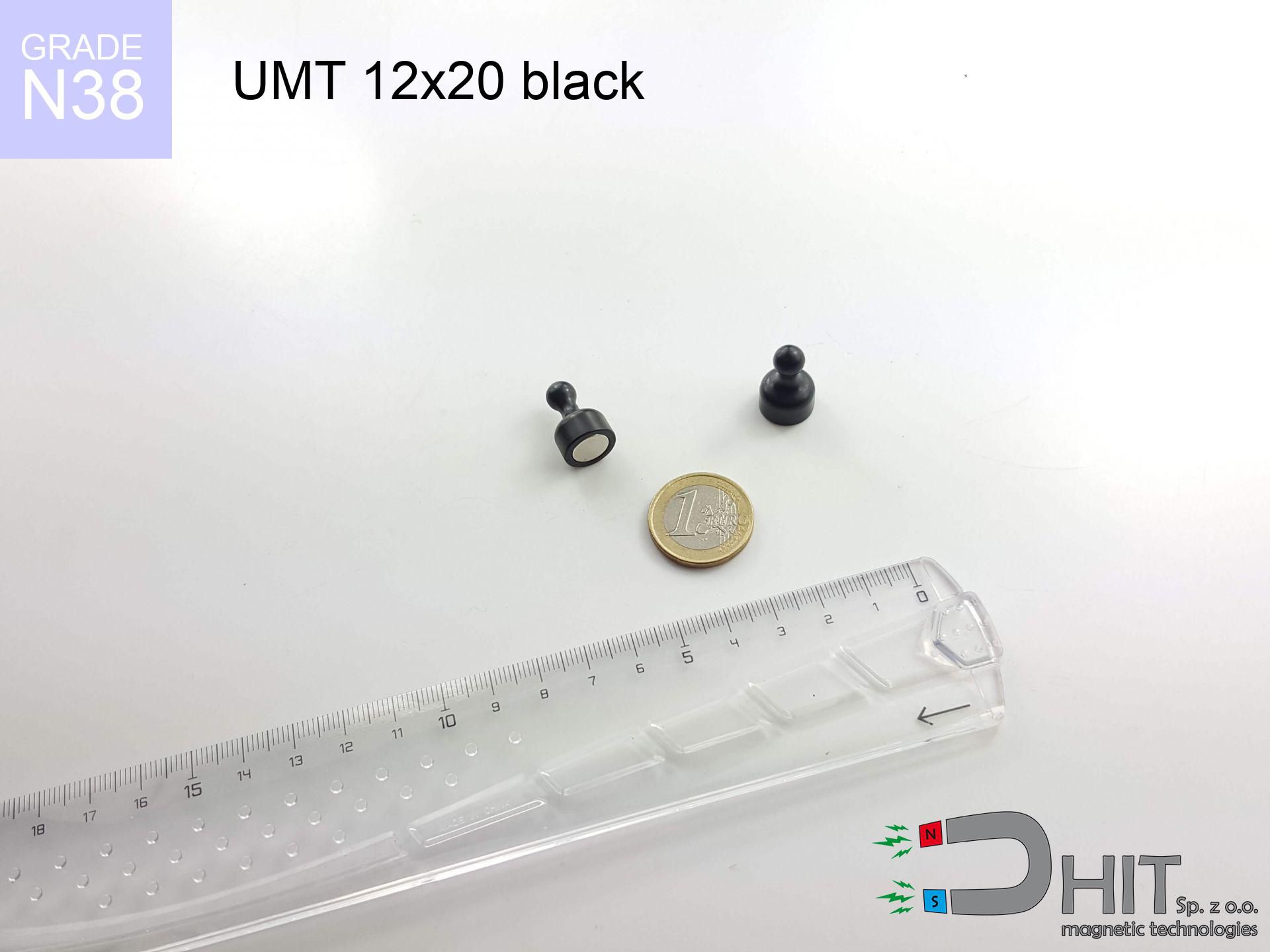UMT 12x20 black / N38 - magnetic pin
board holder
catalog number 230285
GTIN: 5906301814375
diameter Ø
12
mm [±0,1 mm]
height
20
mm [±0,1 mm]
max. temperature
≤ 80
°C
catalog number 230285
GTIN: 5906301814375
diameter Ø
12 mm [±0,1 mm]
height
20 mm [±0,1 mm]
max. temperature
≤ 80 °C
1.89 ZŁ gross price (including VAT) / pcs +
1.54 ZŁ net price + 23% VAT / pcs
bulk discounts:
need more quantity?Want a better price?
Give us a call tel: +48 22 499 98 98 or contact us through contact form on our website. You can check the mass as well as the shape of neodymium magnets in our power calculator magnetic calculator
Orders placed by 2:00 PM will be shipped on the same business day.
Specification: board holder 12x20 black / N38
Magnetic properties of the material N38
Physical properties of sintered neodymium magnets Nd2Fe14B
Choose recommended products
Advantages as well as disadvantages of neodymium magnets NdFeB.
Apart from immense strength, neodymium magnets have the following advantages:
- They do not lose their strength (of the magnet). After approximately 10 years, their power decreases by only ~1% (theoretically),
- They are extremely resistant to demagnetization by external magnetic sources,
- In other words, thanks to the shiny nickel, gold, or silver finish, the element gains an visually attractive appearance,
- They have very high magnetic induction on the surface of the magnet,
- Magnetic neodymium magnets are characterized by very high magnetic induction on the surface of the magnet and can operate (depending on the shape) even at temperatures of 230°C or higher...
- Thanks to the flexibility in shaping or the ability to adapt to specific requirements – neodymium magnets can be produced in many variants of shapes or sizes, which expands the range of their possible uses.
- Key role in modern technologies – are used in HDD drives, electric motors, medical devices and various technologically advanced devices.
Disadvantages of neodymium magnets:
- They are fragile when subjected to a strong impact. If the magnets are exposed to impacts, we recommend using magnets in a metal holder. The steel housing in the form of a holder protects the magnet from impacts and at the same time increases its overall strength,
- They lose strength at high temperatures. Most neodymium magnets experience permanent loss of strength when heated above 80°C (depending on the form and height). However, we also offer special magnets with high temperature resistance, up to 230°C,
- Due to their susceptibility to corrosion in a humid environment, we suggest using waterproof magnets made of rubber, plastic, or other moisture-resistant materials when using them outdoors,
- Limited ability to create threads or complex shapes in the magnet - the use of a housing is recommended - magnetic holder
- Health risk associated with microscopic parts of magnets are risky, if swallowed, which is particularly important in the aspect of protecting young children. Additionally, small elements of these devices are able to hinder the diagnostic process in case of swallowing.
Notes with Neodymium Magnets
People with pacemakers are advised to avoid neodymium magnets.
Neodymium magnets generate very strong magnetic fields that can interfere with the operation of a pacemaker. This happens because such devices have a function to deactivate them in a magnetic field.
Do not bring neodymium magnets close to GPS and smartphones.
Intense magnetic fields generated by neodymium magnets interfere with compasses and magnetometers used in navigation, as well as internal compasses of smartphones and GPS devices.
Dust and powder from neodymium magnets are highly flammable.
Avoid drilling or mechanical processing of neodymium magnets. If the magnet is crushed into fine powder or dust, it becomes highly flammable.
Neodymium magnets can demagnetize at high temperatures.
Under specific conditions, Neodymium magnets can lose their magnetism when subjected to high temperatures.
Neodymium magnets are noted for their fragility, which can cause them to become damaged.
In the event of a collision between two neodymium magnets, it can result in them getting chipped. They are coated with a shiny nickel plating similar to steel, but they are not as hard. In the case of a collision between two magnets, there can be a scattering of small sharp metal fragments in different directions. Protecting your eyes is essential.
If you have a nickel allergy, avoid contact with neodymium magnets.
Studies clearly indicate a small percentage of people who suffer from metal allergies such as nickel. An allergic reaction often manifests as skin redness and rash. If you have a nickel allergy, you can try wearing gloves or simply avoid direct contact with nickel-plated neodymium magnets.
Under no circumstances should neodymium magnets be placed near a computer HDD, TV, and wallet.
The strong magnetic field generated by neodymium magnets can damage magnetic media such as floppy disks, video tapes, HDDs, credit cards, magnetic ID cards, cassette tapes, etc. devices. They can also destroy videos, televisions, CRT computer monitors. Remember not to place neodymium magnets close to these electronic devices.
Magnets will attract to each other, so remember not to allow them to pinch together without control or place your fingers in their path.
Magnets will attract each other within a distance of several to about 10 cm from each other. Don't put your fingers in the path of magnet attraction, because a serious injury may occur. Depending on how massive the neodymium magnets are, they can lead to a cut or a fracture.
Keep neodymium magnets far from youngest children.
Neodymium magnets are not toys. Do not allow children to play with them. In the case of swallowing multiple magnets simultaneously, they can attract to each other through the intestinal walls. In the worst case scenario, this can lead to death.
Comparing neodymium magnets to ferrite magnets (found in speakers), they are 10 times stronger, and their power can shock you.
Read the information on our website on how to properly utilize neodymium magnets and avoid significant harm to your body and unintentional disruption to the magnets.
So that know how strong neodymium magnets are and why they are so dangerous, see the article - Dangerous very powerful neodymium magnets.


![search holder 94x40 [3xM10] GW F550 Silver Black Lina / N52 ↑ axial search holder 94x40 [3xM10] GW F550 Silver Black Lina / N52 ↑ axial](https://cdn3.dhit.pl/graphics/products/ump-94x40-3xm10-gw-f550-lina-gub.jpg)
![magnetic separator 25x175 [2xM8] / N52 magnetic separator 25x175 [2xM8] / N52](https://cdn3.dhit.pl/graphics/products/sm-25x175-2xm8-gif.jpg)

![search holder 94x40 [3xM10] GW F550 Silver Black / N52 ↑ axial search holder 94x40 [3xM10] GW F550 Silver Black / N52 ↑ axial](https://cdn3.dhit.pl/graphics/products/ump-94x40-3xm10-gw-f550-fad.jpg)

